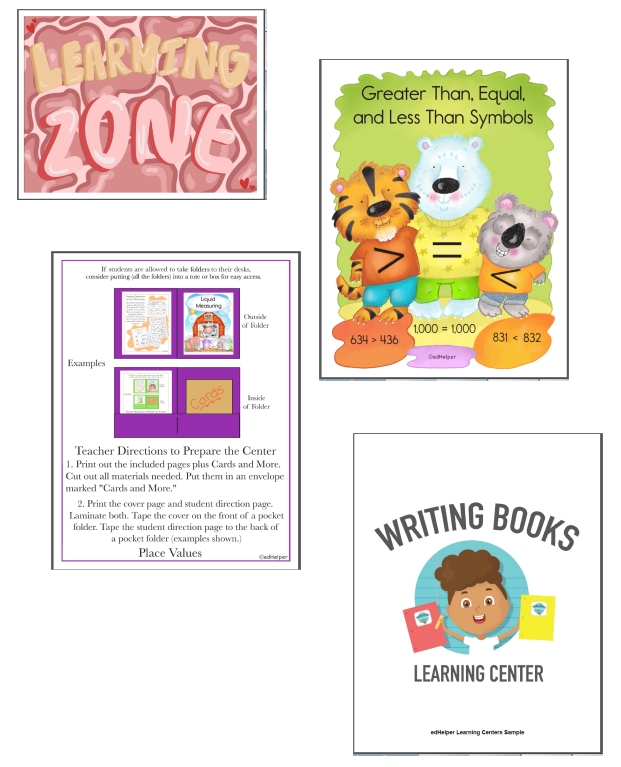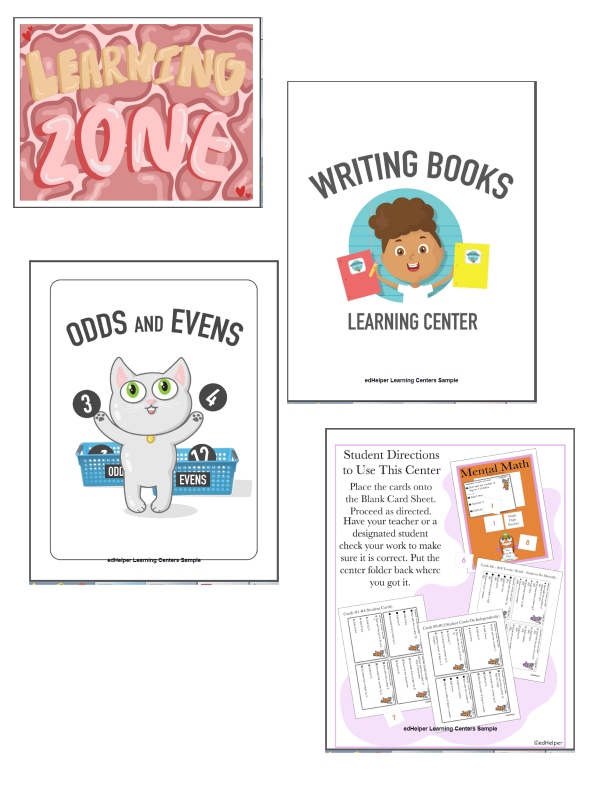7 Tips For Success When Setting Up Learning Centers
By: edHelper Staff
Updated: Jan 23, 2023

Learning centers come with unlimited potential. They can cover any topic, contain a wide variety of activities, support student learning, and give you-the teacher-more breathing room when providing individual and small-group instruction.
All that unlimited potential means there's always a new idea to try, but it also means that getting started can be intimidating. With so many options, how do you even go about setting up a successful center?
It doesn't matter if you're a new teacher looking to get started with centers for the first time or you're a seasoned teacher who wants to optimize student learning at a center that doesn't seem to be working quite right.
These seven tips will set you up for success, regardless of the age of your students or what subject you're teaching.
#1 - Types of Learning Centers
Types of learning centers aren't just the subject matter students are practicing or what activities they are engaged in. Learning center activities should meet the students where they are in their learning.
That means deciding between:
- Enrichment centers
- Skill centers
- Exploratory centers


Enrichment centers
Enrichment centers are loosely tied to the curriculum. Their activities relate to a topic being studied, but the activities themselves aren't part of regular instruction. This type of center allows students to pursue a topic in a myriad of ways, hopefully increasing their interest in the topic.
For example, an enrichment center activity during a science unit on nature might include leaf rubbing or categorizing a pile of rocks based on their size, shape, or color.
Skill centers
Skill centers are heavily tied to the curriculum. They include activities that directly relate to a concept or skill taught during large group instruction. The goal of a skill center is to give students the ability to practice a skill as part of a small group, in a pair, or individually, reinforcing the information that was presented.
For example, a skill center activity during a math unit on addition might include a game in which students roll a pair of dice and add the digits, with the student with the highest number winning the round.
Exploratory centers
Exploratory centers aren't usually tied to a particular lesson or the curriculum, although they can be. This type of center is focused on allowing students to make meaningful discoveries on their own. Most activities are interactive or hands-on.
An example of an exploratory center might be asking students to make something out of a box of trash (empty plastic bottles, tin cans, toilet paper tubes, etc.) or allowing students to play with building materials like Legos or blocks.
#2 - When to Use Learning Centers
Learning centers are great during reading when you want to meet with small groups (including those for math) or when you want students to practice important skills on their own, but there are other times learning centers can be beneficial, too.
Have centers out in the morning as students arrive so they have something to do before school starts. Centers can be used if you finish an activity early, and they are a great way to give your students something to do during inside recess. They can fill time for a substitute teacher, too, as long as your students have plenty of practice doing centers independently.
#3 - Make It Easy
Don't feel like you have to spend hours developing center activities and setting them up. Some of the best activities take just minutes to plan. A few examples include keeping the same activity but, for instance, switching out math cubes for buttons to make counting more interesting or adjusting an addition activity for subtraction by using the same spinner.
Worksheets can be effective center activities, too! Plus, they are convenient. They can be pulled out of a drawer whenever you need a new activity for a center.
The trick is to choose engaging worksheets that support learning. You can make filling out a worksheet at a center a little more exciting if you allow students to complete them in pairs instead of doing them alone. Allowing students to use manipulatives when completing worksheets can make them more fun, too.
Ask other teachers for the activities they use in their centers, and catalog everything as you go. After a few years, you'll have a bank of activities you can pull from. And who knows? When you've got a great list of activity ideas you can use at any time, you may finally have time to plan that elaborate center you've been dreaming about!
#4 - Review the Rules
Students need rules, and they need specific rules. If you aren't crystal clear about your expectations, you can bet that students are going to try your patience.
Outline the rules you have for learning centers, make them visual, and post them on the wall. Everything from how far students can wander from each station to how loud they can be to what they should do if they finish early should be addressed.
Then, revisit the rules often, engaging students in the discussion. Are there any rules they think you should add? Create the rules together as a class, and your students will be more likely to follow them.
#5 - Gradual Release of Responsibility
It makes sense that kindergartners will have trouble using stations at first because it's a brand-new concept, but don't assume second- or third-graders will be able to jump right in either. It's important to gradually release responsibility over time, regardless of the age of the students you're working with.
You may have to observe students for a few weeks, gently reminding them of the rules before you can start meeting with a group while stations are in full swing. Depending on the dynamics in your classroom, you may have to have students start alone or in pairs before allowing small groups to work together. You should also start with simple activities and save complex or messy activities for when you trust students to follow the rules and work independently at learning centers.
If you're planning a skill center, you have to make sure they are ready for the work at the station. That means providing a focus lesson and guided instruction before students can collaborate or work independently.
#6 - Let Students Regulate Themselves
Whenever possible, you should let students choose which stations to go to and how long they are there. This allows students to work at a comfortable pace without having a meltdown because they didn't get to finish what they were doing before the timer went off.
This strategy also encourages self-regulation. Students are required to determine whether it's time to move to a new center without being prompted by a timer or a teacher. Even if you have to nudge a student from a center, the conversation is about letting other kids work at that center too. The conversation isn't about following external guidance. Helping students learn to self-regulate is a skill that will serve them later in life.
Most importantly, self-regulated centers are easier for teachers to manage. You don't have to spend precious time arguing with students or dealing with the meltdowns that are common when students must rotate to a different center after a certain period of time.
Have a center that's hugely popular that students in your class tend to fight over? Set up two stations with the same activity so every student who wants to participate can!
# 7 - Assess Student Learning
It is important to assess student learning at skill centers. If students are struggling or are getting frustrated while working, you might have to go back and reteach the concept with another lesson before letting them try the learning center again.
It's not just skill centers that require assessments. Student learning should be assessed at enrichment and exploratory centers too!
Is there a popular enrichment center activity you can expand on during instruction? Did a student learn something interesting during an exploratory center that they want to share with the rest of the class? Have your students' fine motor skills increased? You can learn a lot about your students when you assess their activities in classroom centers!














